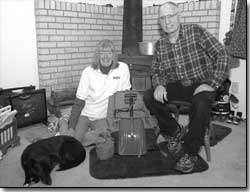|
by Amy Maestas
 |
Kathy and Don Fritch
relax by a fire with their dog, Rocket, and Kathy's
famous
backcountry survival pack in their home near Durango./Photo
by Todd Newcomer. |
Kathy Fritch teaches that it takes only about 20 pounds
and a good backpack to save your life. At least if you
are off skiing in the styx. Pack it once, she says, and
you only have to update it as things wear out and as you
consume some of the contents. Otherwise, Fritch, the doyenne
of Ski Hesperus patrollers, urges people who venture into
the backcountry to keep the pack always ready to go.
Fritch’s own pack is popular, especially among
people who have taken her and her husband’s avalanche
courses. Without fail, part of the course is dedicated
to Fritch’s pack and its purpose. Once she espouses
its life-saving contents, nearly everyone walks away with
an image of Fritch’s pack in order to create one.
Fritch stuffed her pack the first time more than 30 years
ago, when she was part of the group forming the La Plata
County Search & Rescue team. Drawing from her own
backcountry experience, she knew the essentials of survival.
“The whole idea is to get what you need and put
it in a pack,” Fritch explains. “When you
go off skiing or something in a place where you can’t
get back to your car by dark, if you get lost, then you
need to take a pack like this. Once you drop down behind
some ridge or hill, you’ve suddenly increased your
chances for needing it.”
Fritch meticulously designed the pack’s contents.
First in the pack is a bivouac sack. Like every other
item in the pack, Fritch made it. She doesn’t believe
people need to spend hundreds of dollars on high-tech,
name-brand gear to stuff the pack. Most of her stuff –
quilted ski pants, booties – is made from things
she bought at thrift stores.
“It’s all stuff that’s easy to find.
You just have to be creative,” she says.
Besides warm clothing, Fritch says packs should contain
enough food for one evening and one morning and not necessarily
meals fit for a king. The food should be light enough
to carry yet have enough sustenance that you are able
to take in enough fuel to wait out a crisis (peanut M&Ms
are a favorite).
Other items include waterproof matches, a pocket knife,
a tin cup, compass, extra ski basket, and twine or rope,
should an injured skier need to make a sled out of his
or her skis.
Over the years, Fritch has changed the contents of her
pack – though only slightly. When using the pack
(which she has done as part of rescue efforts), she notices
what could be replaced with a more useful item. Some things,
she says, you never end up using.
“If you are out there and you say, ‘I really
wish I had this or that,’ then you probably need
to put it in your pack,” she adds.
But the weight limit strictly remains. Once you add something
to a pack that puts it over 20 pounds, you need to yank
it out, she says. Right now, Fritch says her pack weighs
in at only 19 pounds – and she’s proud of
it.
“It has what I need if I end up spending a night
in the wilderness.”
|

